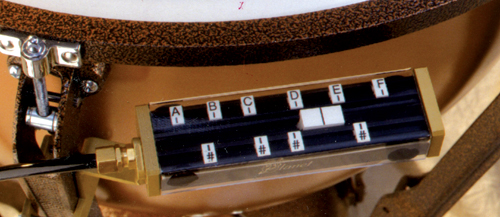
Band directors, even those who are percussionists, may not always have a clear approach to solving percussion problems in rehearsal. These moments can consume extra time, alter rehearsal momentum, and be frustrating for both director and students. The following are some possible solutions for common percussion problems in rehearsal.
Playing in Time
Percussionists must know what steady time is and how to play rhythms in that flow of time. Work with a metronome can be useful to develop steady time, but if this beat is not internalized, problems can resurface when the metronome is taken away. Stepping with the time and clapping or sizzling rhythms with steady time can increase students’ sense of steady beat. Percussionists should also practice alone with a metronome to make sure they can play a given passage correctly and that they are not rushing or dragging specific rhythms.
Additionally, rhythms may sound incorrect if the stroke begins early or late. Watch for students waiting to start the stroke until the moment they should be striking the instrument. Depending on tempo, the student may need to start a stroke as much as a beat before they should be striking. Also monitor instrument and stand setup so students can see their music while seeing their instrument beating area and the conductor peripherally.
Snare Drum
The snare drum is too loud.
One possible reason is that the stroke height is too high. Coach snare players to listen to the group around them and avoid playing louder than a certain section. Students may also be unaware that dynamics are relative and that their piano may be the director’s mezzo forte.
Another cause may be using a stick that is too large. A 2B stick is generally a good size for concert snare drum.
If the snare player is getting a thuddy or smacky sound, make sure he isn’t ending each stroke close to the head. The stick should generally come back up to the height at which it started; this will give a more characteristic sound.
The snare drum always sounds behind.
If the snare drum always sounds behind, the player may need to place their notes further in front of the beat. Some students interpret this as being asked to rush, but there is a difference. Make clear the tempo should be followed strictly but the snare should play slightly before the rest of the group. If the student does this, it will likely sound more correct to the director.
Even when students are aware of the problem they sometimes cannot fix it. They may be starting the stroke when they should be striking the drum, which can cause them to sound behind. Snare drummers should make sure their first movement is down and not up, which will help the note sound in time.
Rolls are uneven.
Work with percussionists on the pressure they are using in each hand; more pressure will lead to a more closed roll sound, while less pressure will lead to a more open roll sound. If the roll is uneven, the student may need to increase roll speed (the number of times the hands alternate during a rolled note). Attention should also be given to grip pressure; too firm a grip will cause the stick to bounce less on each stroke and can cause unevenness.
There is an unpleasant ringing sound.
It can be difficult for a busy band director to maintain the tuning of a snare drum enough to eliminate this ringing without applying any dampening. Once the heads are properly tuned (on a 6.5" drum, the top head should be tuned to A and the bottom head tuned a fourth or fifth lower) and the snare tightened so there is not excessive ring but still a snare sound, a more practical solution is some type of dampening on the head. Common dampeners are usually made out of either gel or leather.
Timpani
The drums sound thuddy or uncharacteristic.
Make sure timpanists use a proper stroke. In simplest terms, the mallet should come back to the point at which it started. The mallet must not stay on the head very long at the point of contact, which is why you hear lots of directors coaching students to “Come out of the head.” I have had a lot of success doing the stroke with my hand about halfway up the shaft while the student grips the mallet at the bottom. This gives the student a feel for how the stick should move.
The director can also monitor the striking area, which is over the pedal and between tension rods. Striking over the tension rods will give a less resonant sound. The amount you play in from each edge depends on the size of the drum, measured from the bearing edge; timpanists should play closer to the edge the smaller the drum is. These distances work out to approximately 2-3" for a 23" drum, 3-4" for a 26" drum, 3.5-4.5" for a 29" drum, and 4" or more for a 32" drum. Remember to go by how the instrument sounds rather than strict measurements.
Rolls sound poor.
First, make sure the timpanist is not attempting buzz rolls. Only use single-stroke rolls on timpani. Then give the student an idea of what they are working for. The roll should sound like a note of the same length sustained by a wind or string instrument. The number of strokes in an unmeasured roll is determined by the desired sound, not by the duration of the note. If you hear the strokes of the mallet more than the sustain of the head, you may need to increase the roll speed. However, if the roll speed is too fast, the head does not have time to rebound, which can choke the sound and decrease resonance. Also, make sure the students’ hands are spread apart about six inches. This will also help the head breathe. Remember, the size of the drum helps determine roll speed, so use a slower speed for a larger drum and a faster speed for a smaller drum.
Each stroke sounds different.
Make sure the student isn’t playing on the seam of the felt (usually marked with a black dot), which can lead to a different sound from each mallet. Also watch the type of stroke each hand makes. Sometimes students play legato (less velocity, more relaxed grip) in one hand and staccato (faster velocity, less relaxed grip) in the other, which creates different sounds in each hand. Check the distance each hand is from the rim. If one is two inches away and the other is four, each hand will sound different.
The timpani pedal moves by itself.
This can be complicated, but the first thing to do is to make sure that when the heel of the pedal all the way down, the 32" drum sounds D2, the 29" drum sounds F2, the 26" drum sounds Bb2, the 23" drum sounds D3, and the 20" drum sounds F3. This sometimes can solve the problem altogether. If it doesn’t, there might be a problem with the horizontal pull rod under the drum, which is likely to require the assistance of a professional.
Mallets
Some of the notes are thuddy.
Often students end up playing on the area of the bar the cord runs through, known as the node. This can give a much less resonant tone than striking in the middle or on the very edge of the bar. Make students aware of passages where they are playing on the node. They will likely need to slow these passages down to relearn proper mallet placement.
Notes have heavy accents and decay too quickly.
Students who do not come back to the point at which they started a stroke but rather leave the mallet down (sometimes known as a downstroke) may create a tone that is less resonant and has more front on the sound. Monitor the way the head of the mallet travels as students play, as this is important in tone production.
The passage isn’t loud enough.
Mallet height at the beginning of the stroke generally determines volume. Students who start at a lower height than they should may struggle to create a given dynamic. For example, starting two inches off the keyboard is usually too low to create the sound needed for a fortissimo passage. If students are starting low, ask them to play twice their starting height and see if they get the desired volume. If they are still too quiet, have them increase the starting height more until the volume is correct. Coaching students on setting mallet heights based on the dynamics will help get the desired volume.
Crash Cymbals
I don’t know which crash cymbal technique is correct.
The most important factor is the sound. There is no one right technique; each player will have to find what works best for them. One possible technique to start with is to have the student hold one cymbal in his non-dominant hand vertically and then move only the dominant-hand cymbal at an angle into the vertical cymbal, striking it about two inches below the top. When the student can do this consistently, have him bring the vertical cymbal straight down while at the same time moving the angled cymbal up and in, still striking the dominant-hand cymbal about two inches below the top edge of the non-dominant-hand cymbal. The goal is to get all of both cymbals to vibrate to create a full crash.
Students keep getting an air pocket.
If the edges of the cymbals meet and trap the air between them, the resulting sound contains very little crash and is more of a chunk sound. If enough force is applied and the cymbals are parallel, one cymbal can even flip inside out. One cymbal should be angled to the other to prevent this. In addition, make sure that once the angle is established that the student doesn’t bring the cymbals back to parallel right as they crash.
Crashes are too soft.
The student may not be using enough velocity when bringing the cymbals together. It may also be necessary to increase the angle of one cymbal.
Check the grip, as some players put their entire palm on the cymbal, muffling it. The proper grip for concert crash cymbals is to grab the strap between the index finger and thumb and hold the strap with the rest of the fingers. The hand should stay off the cymbal as much as possible.
Crashes are inconsistent.
Cymbals have a heavy spot, which should be at the bottom so the cymbal does not rotate when played. You may need to mark the top of the cymbal when the heavy spot is at the bottom so students know where to have the cymbals set. More often though, the problem is that the player can’t replicate the same cymbal angle, striking point, and velocity with each crash. These variables must be as identical as possible to get a consistent crash. To do this requires practice.
Soft crashes don’t get the sound I want.
Start with the cymbals touching with a slight offset, then separate and draw the right hand down. You may also consider holding the cymbals together for a moment longer, sometimes called a kiss, after the first impact. This can give the sound of the soft crash more breadth.
These are possible solutions for the most frequent percussion problems. Attention given to these details will likely result in a more refined percussion sound for the group.






